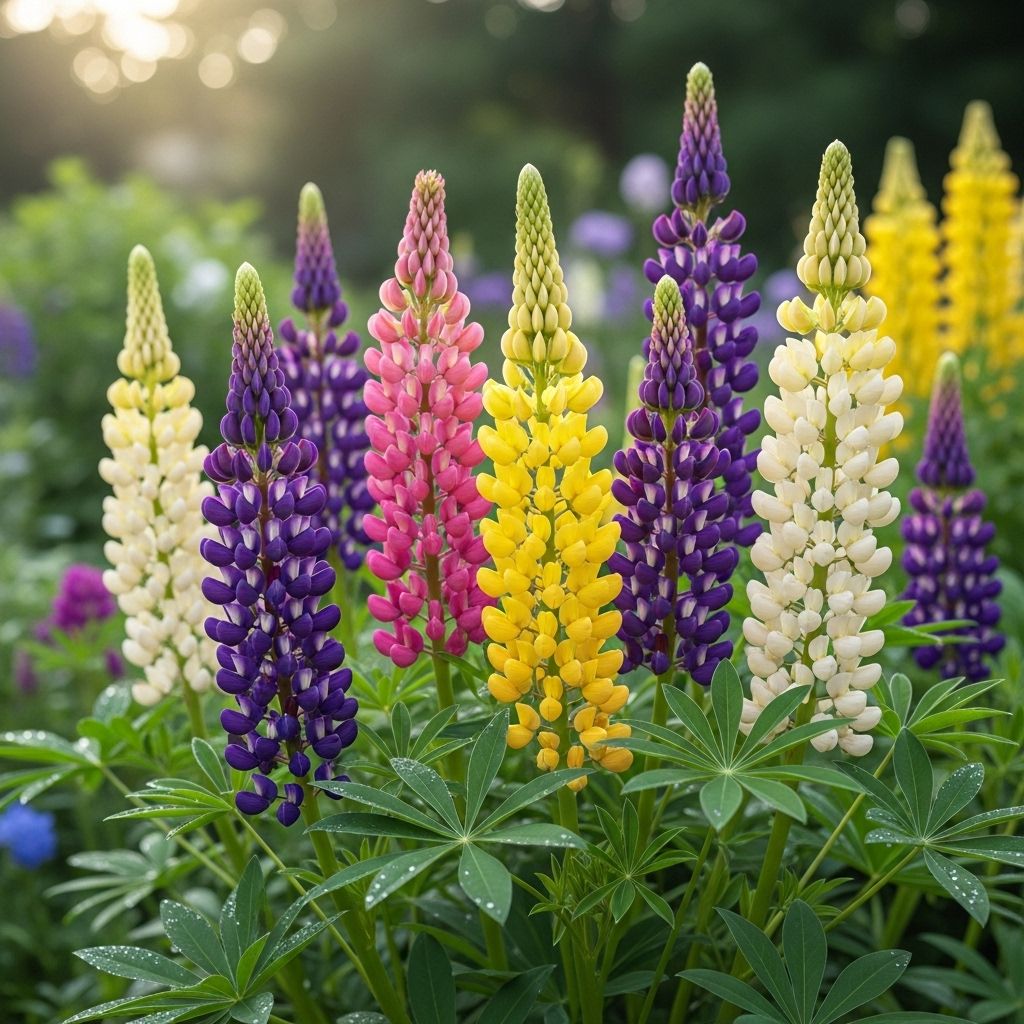How To Grow Lupines: Comprehensive Guide For Vibrant Spires
Discover the beauty, diversity, and how-to for growing lupines in your garden—from wild blooms to vibrant hybrids.

Image: HearthJunction Design Team
Everything You Need to Know About Lupines
Lupines are among the most beloved garden flowers, captivating gardeners and nature lovers with their brilliant spires of blooms and fascinating foliage. With hundreds of species and numerous hybrids, lupines offer unmatched diversity and color to landscapes across North America and beyond. This guide will walk you through the types, planting, care, and design inspirations for lupines, while also answering the most common questions about their cultivation and benefits.
What Are Lupines?
Lupines, sometimes spelled lupins, are members of the pea family (Fabaceae). These nitrogen-fixing legumes are cherished for their upright spires of densely packed flowers, which can range from cool blues and purples to fiery pinks, reds, yellows, and even bi-colors. Lupines can be annuals, short-lived perennials, or even long-lived perennials depending on the species and growing conditions.
- Common Names: Lupine, lupin, bluebonnet
- Botanical Name: Lupinus spp. and hybrids
- Family: Fabaceae
- Plant Type: Herbaceous annual or perennial
- Typical Size: 1.5–4 feet tall, 1–1.5 feet wide
- Sun Exposure: Full sun preferred
- Soil: Well-drained, sandy or average soil; avoid clay
- Bloom Time: Spring to midsummer
- Flower Colors: Blue, purple, pink, white, yellow, red, bicolors
- Hardiness Zones: 4–8 (USDA)
- Toxicity: All plant parts are toxic if ingested
Lupine Types and Notable Varieties
With over 200 species worldwide and countless hybrids, lupines offer a broad range of options for gardeners, from native wildflowers to bold, show-stopping cultivars. Here are some of the best-known lupine species and hybrids:
Lupine Species
- Garden Lupine (Lupinus polyphyllus): Native to western North America; features blue, pink, and purple flowers; prefers moist environments.
- Wild Lupine (L. perennis): Native to the eastern United States; blue perennial flowers loved by pollinators.
- Texas Bluebonnet (L. texensis): The state flower of Texas; annual plant with vivid blue and white flowers; carpets fields in spring.
- Harlequin Lupine (L. stiversii): Known for striking yellow-to-purple gradient blooms; native to Sierra Nevada in California.
- Sky Lupine (L. nanus): Iconic California-Nevada annual; short and delicate, often blooms during superblooms alongside California poppies.
- Summer Lupine (L. formosus): Drought-tolerant West Coast species, attractive to butterflies.
Popular Hybrid Lupines
- Russell Hybrids: The most widely grown perennial garden lupines. Offer tall spires with a rainbow of colors. Hardy, reliable—and the basis for many new cultivars.
- Russell Lupine Mix: An easy-to-grow seed mix known for its diverse and tall flower spikes.
- Woodfield Hybrids: Perennials noted for their deep colors and striking bi-colored blooms.
- Dwarf Hybrids (‘Dwarf Lulu,’ ‘Minarette’): Compact varieties reaching only 1.5 to 2 feet tall, ideal for containers and small spaces.
Where Do Lupines Grow Best?
Lupines are highly versatile but tend to perform best under certain conditions:
- Sunlight: Full sun (at least 6 hours direct sun per day) produces the sturdiest plants and richest blooms.
- Soil: Prefer loose, sandy, or average soil. Avoid heavy clay—amend or raise beds if necessary. Their deep roots appreciate well-drained conditions.
- Moisture: While some species tolerate drought, most garden lupines thrive with consistently moist but not soggy soil.
- Fertility: As members of the pea family, lupines enrich the soil by fixing nitrogen, making them great for improving garden beds over time.
- Climate: Best suited to cooler climates; most grow well in USDA zones 4–8.
How to Plant Lupines
Planting lupines is relatively simple, but following a few key steps will ensure healthy, robust growth:
Starting Seeds
- Pre-soak Seeds: Lupine seeds have hard coats. Gently nick or soak them in warm water for 24 hours before sowing for better germination.
- Direct Sowing: Sow seeds outdoors in early spring or fall, lightly covering with soil. They germinate best in cooler temperatures.
- Transplanting: If starting inside, use biodegradable pots since lupines dislike root disturbance. Transplant carefully.
Site Preparation
- Choose a spot with full sun exposure and well-drained, slightly acidic to neutral soil (pH 6.0–7.0).
- Work in organic matter if soil is poor. Raised beds are ideal where drainage is an issue.
Planting Nursery Plants
- Dig a hole twice as wide as the pot; gently transfer the plant, keeping the root mass intact.
- Space perennial lupines 1–1.5 feet apart for best air circulation and vigor.
Growing and Caring for Lupines
Lupines can reward you with years of vivid blooms if given the right care. Here’s how to keep them thriving:
- Watering: Water regularly during dry spells, especially in the first year or when growing in hot climates. Avoid waterlogging.
- Mulching: Apply mulch to conserve moisture and suppress weeds, but keep mulch away from plant stems to prevent rot.
- Feeding: Usually, no additional fertilizer is needed. Avoid high-nitrogen feeds, which favor leaves at the expense of blooms.
- Deadheading: Remove spent flower spikes to encourage more blooms and prevent unwanted self-seeding.
- Staking: In windy areas, tall varieties may need support to prevent lodging.
- Division: Lupines generally dislike being moved or divided. If necessary, do so early in spring, moving as much root as possible.
Design Ideas: How to Use Lupines in the Garden
The towering, colorful spikes of lupines make them excellent for:
- Mixed Borders: Pair them with other upright perennials like delphiniums, foxgloves, or irises for dramatic color contrasts.
- Cottage Gardens: Their old-fashioned charm fits perfectly among peonies, daisies, and roses.
- Wildflower Meadows: Use native species and hybrids to attract pollinators and create a natural look along with poppies and coreopsis.
- Containers: Dwarf varieties excel in large pots and patio planters.
Wildlife and Ecological Benefits
- Pollinator Friendly: Lupines attract bees, butterflies, and hummingbirds, making them valuable for supporting pollinator populations.
- Caterpillar Host: Several species are host plants for butterfly larvae, such as the endangered Karner blue butterfly and Acmon blue.
- Nitrogen Fixation: Improve soil fertility naturally by converting atmospheric nitrogen into a form plants can use.
Pests, Diseases, and Potential Problems
- Pests: Aphids can be a problem, especially on tender shoots. Use an insecticidal soap or attract ladybugs to manage them.
- Diseases: Powdery mildew and root rot may occur if plants are crowded or grown in heavy, soggy soil.
- Toxicity: All parts of the lupine plant, especially seeds, are toxic if ingested by humans, pets, or livestock.
- Invasiveness: Some wild lupines can escape cultivation and become invasive. Plant responsibly and remove faded flowers if reseeding is a concern.
Frequently Asked Questions (FAQs)
Are lupines annuals or perennials?
Lupines can be both annuals and short-lived perennials depending on the species and local conditions. Most garden hybrids, like Russell hybrids, are perennials that live two to five years if well cared for.
Do lupines attract pollinators?
Yes, lupines are beloved by bees, butterflies, and even hummingbirds. They are a valuable nectar source and also serve as host plants for some butterfly caterpillars.
How do you prevent lupines from becoming invasive?
Deadhead spent flowers promptly to prevent self-seeding, and avoid planting near natural areas where they might escape into the wild. Monitor for seedpods, and remove unwanted seedlings early.
Can you grow lupines in containers?
Absolutely. Choose dwarf hybrids and plant in large, deep pots to accommodate their taproots. Ensure pots have good drainage and avoid crowding.
What causes lupine leaves to turn yellow?
Yellowing leaves are usually a sign of too much moisture or poor drainage. Improve soil drainage and reduce watering frequency.
Are lupines toxic?
Yes. All parts of the plant, especially seeds, can be toxic if ingested. Keep out of reach of children and pets, and avoid planting where grazing animals roam.
Quick Reference: Lupine Planting Table
| Aspect | Recommendation |
|---|---|
| Sun Exposure | Full sun (6+ hours daily) |
| Soil | Well-drained, sandy to average |
| Watering | Moderate; keep evenly moist, not soggy |
| Spacing | 12–18 inches apart |
| Bloom Time | Spring to midsummer |
| Height | 1.5–4 feet, depending on variety |
Final Thoughts
Lupines are a spectacular addition to any garden, offering beauty, diversity, and ecological benefits. From the rolling fields of Texas bluebonnets to the cottage garden borders of Russell hybrids, there’s a lupine for every landscape and gardener. With a little careful planting and routine maintenance, you’ll enjoy these dramatic flowers—and the pollinators they invite—for years to come.
References
Read full bio of Srija Burman












